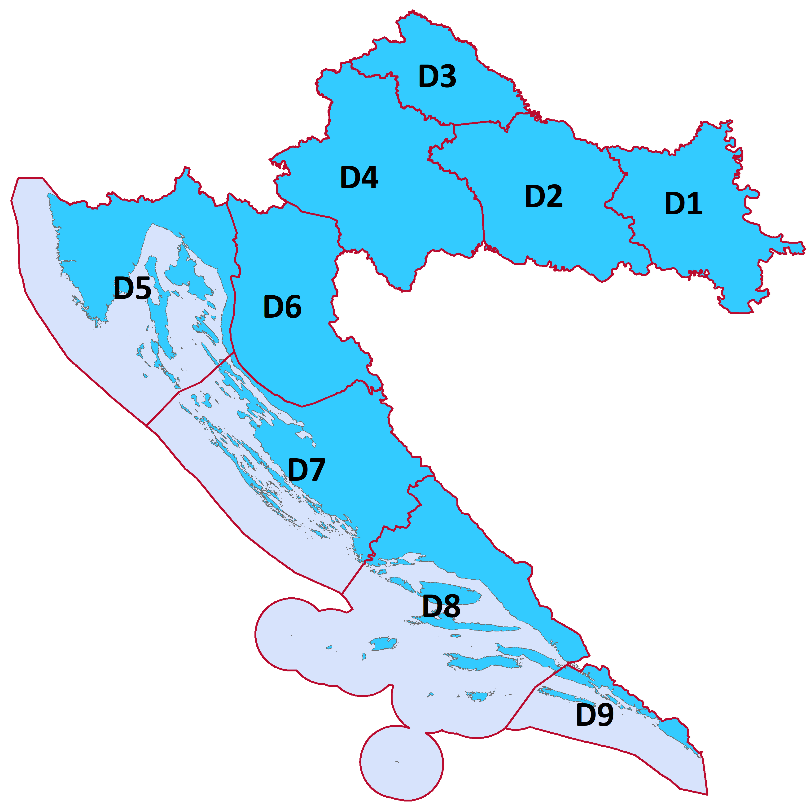Switching off DVB-T Signals as of next Tuesday, only DVB-T2 remains in operation

| Digital Region |
County |
Switchover |
|
D1
|
Osijek-Baranja, Vukovar-Srijem, part of Brod-Posavina |
27.10.20. at 0:00 |
|
D2
|
Part of Bjelovar-Bilogora, Virovitica-Podravina, Požega-Slavonia, part of Brod-Posavina |
29.10.20. at 0:00 |
|
D3 |
International, Varaždin, Koprivnica-Križevci, part of Bjelovar-Bilogora |
3.11.20. at 0:00 |
|
D4 |
City of Zagreb, Zagreb, Sisak-Moslavina, part of Krapina-Zagorje, part of Karlovac |
3.11.20. at 0:00 |
|
D5 |
Primorje-Gorski Kotar, Istria, part of Lika-Senj |
10.11.20. at 0:00 |
|
D6 |
Part of Karlovac, part of Lika-Senj |
27.10.20. at 0:00 |
|
D7 |
Zadar, Šibenik-Knin, part of Lika-Senj |
5.11.20. at 0:00 |
|
D8 |
Split-Dalmatia, part of Dubrovnik-Neretva |
12.11.20. at 0:00 |
|
D9 |
Part of Dubrovnik-Neretva |
10.11.20. at 0:00 |
It should be quoted that after switching off the DVB-T transmitter, it will be necessary to search television programs on the receiver again so that they can be viewed in the DVB-T2/h.265 HEVC system. This will also have to be done if we are already watching HD programs in the new system because the current television channels (frequencies) for transmission will be replaced by the final one after the simultaneous operation of DVB-T and DVB-T2 systems on a particular transmitter is completed.
This transition applies only to those citizens who watch digital terrestrial television. All those watching the television through other platforms (IPTV, cable television, satellite television) will not have to change their reception equipment, nor will the transition in any way affect them.
All those who have televisions more than 3years or TV aimed to watch terrestrial TV, use standalone receivers purchased to watch terrestrial television, will certainly need to have new receiver equipment. If users are not sure if their equipment supports the new DVB-T2 system, or if this is not clearly indicated on the devices, it is proposed to search the channels again and verify that the detected channels of Croatian national television have the “HD” sign in the corner. The label indicates that the image is in high resolution and that they receive a new DVB-T2 signal, not the old DVB-T. The price of cheaper individual receivers today ranges between 150 and 200 HRK but if users have old TV that can display the image only in a standard resolution (quality), instead of acquiring an independent receiver, they can also consider of buying a new television capable of showing the image installed on their old television, otherwise the image will still be shown in its previous quality despite the new independent receiver.
For more information please contact the following link
# # #
For additional information please contact:
Croatian Regulatory Authority for Network Industries (HAKOM)
Roberta Frangeša Mihanovića 9
10110 Zagreb, Croatia
Tel. + 385 (0) 1 700 70 07
Fax + 385 (0)1 700 70 70
Media inquiries can be submitted online using HAKOM’s official website: https://www.hakom.hr/
Registration required.
Za sve dodatne informacije molimo kontaktirajte:
Hrvatska regulatorna agencija za mrežne djelatnosti (HAKOM)
- Ulica Roberta Frangeša-Mihanovića 9
- 10110 Zagreb
- Tel: +385(0)1 700 70 07
- Faks: +385(0)1 700 70 70
Novinarski upiti postavljaju se na službenoj web stranici HAKOM-a na adresi: www.hakom.hr
O Hakom-u
HAKOM - Hrvatska regulatorna agencija za mrežne djelatnosti – osigurava pretpostavke za ravnopravno tržišno natjecanje, stabilan rast i prostor za inovacije na tržištima elektroničkih komunikacija te poštanskih i željezničkih usluga. HAKOM štiti interese korisnika i osigurava mogućnost izbora usluga po prihvatljivim cijenama, određuje održive konkurentne uvjete operatorima, davateljima poštanskih usluga i željezničkim prijevoznicima uz pravedne uvjete za povrat ulaganja te pruža podršku ekonomskom rastu, javnim uslugama i kakvoći života u RH primjenom suvremenih tehnologija. Strateški ciljevi HAKOM-a su unaprjeđenje regulacije tržišta elektroničkih komunikacija te željezničkih i poštanskih usluga, podržavanje rasta ulaganja i inovacija u tržišta, učinkovita uporaba ograničenih resursa, ubrzani rast širokopojasnih usluga, velika ponude komunikacijskih, željezničkih i poštanskih usluga, zaštita i informiranje korisnika, izgradnja učinkovitog i sveobuhvatnog informacijskog sustava, određivanje i ugradnja učinkovitih procesa te stjecanje multidisciplinarnih stručnosti i znanja u području reguliranja tržišta.